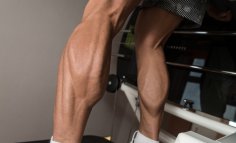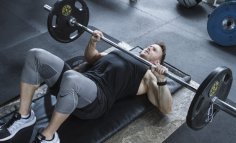Myth #2: Full Squats (below parallel) Are Bad For The Knees
More squat myths?!?
We’ve all heard it, if you dip below parallel during a squat, your kneecap will blow off and land in the front desk girl’s mocha latte. Well it just ain’t true! What’s that, you need a little more evidence? Ok boys and girls, its time for today’s episode of Fun With Musculoskeletal Anatomy.
The knee has four main protective ligaments that keep the femur from displacing on the tibia (ACL, PCL, MCL, LCL). These four ligaments are most effective at their protection during full extension and full flexion. Full extension would be when you are standing; full flexion would be when there is no daylight between your hamstring and your calf. When the knee is at 90 degrees of flexion (the halfway point), these four ligaments are almost completely lax and cannot exert much if any of a protective force at the knee (Zatsiorsky V. Kinematics of human motion. 1998 - published by Human Kinetics - p.301).
Unfortunately, the position where the protective ligaments of the knee are not doing any protecting is the common recommended stopping point of a squat. Therefore, as it as it turns out, this is the exact worst place you could reverse the motion under load.
If flexibility allows (heels staying planted, torso not flexing forward past 45 degrees), then a full squat where you lower yourself all the way to the ground is far safer on the knees than the traditional half squat. Guess what joint angle most leg extension machines start at? If you said 90 degrees, give yourself a pat on your healthy knee. This makes a full squat even safer than a leg extension machine (Wilk K et al. A comparison of tibiofemoral joint forces and electromyographic activity during open and closed kinetic chain exercises. Am J Sports Med; 24(4):518-527).
So am I telling you never to do parallel squats? No! Am I saying that you’ll injure yourself on a parallel squat? No, again! What I’m trying to do is simply make an argument for the safety of full squats, thereby relegating squat myth #2 to the fiery pits of hades.
___________________________________________________________________________________
The full squat is the preferred lower body exercise for safety as well as athletic strength. Yet physical therapists, orthopedic surgeons, chiropractors [...] regularly condemn the time-honored full range of motion squat as being harmful to the knees and apparently, as a result, to the soul. The squat, when performed correctly, is not only the safest leg exercise for the knees, it produces a more stable knee than any other leg exercise. The important part of the last statement is the "when performed correctly" qualifier. Correctly is deep, with hips dropping below level with top of patella. Correctly is full range of motion.
Any squat that is not deep is a partial squat, and partial squats stress the knee and the quadriceps without stressing the glutes and the hamstrings. The hamstrings and glutes perform their function in the squat when the hip is stretched to the point where they get tight, at full hip flexion - the deep squat position. The hamstring muscles, attached to the tibia and the ischial tuberosity of the pelvis, reach a full stretch at the very bottom of the squat, where the pelvis tilts forward with the torso, stretching the two ends of the muscle apart. At this stretched position they provide a slight rebound out of the bottom, which will look like a "bounce". ... The tension of the stretch pulls the tibia backwards, the posterior direction, balancing the forward-pulling force produced by the quadriceps, which pull from the front. The hamstrings finnish their work, with help from the glutes, by straightening out the hip.
In a partial squat, which fails to provide a full stretch for the hamstrings, most of the force against the tibia is forward, from the quadriceps and their attachment to the front of the tibia below the knee. This produces an anterior shear, a forward-directed sliding force, on the knee, with the tibia being pulled forward from the patellar tendon and without a balancing pull from the opposing hamstings. This shearing force - and the resulting strain on the prepatellar area - may be the biggest problem with partial squats. Many spectacular doses of tendonitis have been produced this way, with "squats" getting the blame.
The hamstrings benefit from their involvement in the full squat by getting strong in direct proportion to their anatomically proper share of the work in the movement, as determined by the mechanics of the movement itself. This fact is often overlooked when considering anterior cruciate tears and their relationship to the conditioning program. The ACL stabilizes the knee; it prevents the tibia from translating forward relative to the femur. As we have already seen, so does the hamsting group of muscles. Underdeveloped, weak hamstrings thus play a role in ACL injuries, and full squats work the hamstrings while partial squats do not. In the same way the hamstrings protect the knee during a full squat, hamstrings that are stronger due to full squats can protect the ACL during [sports]. In fact, athletes who are missing an ACL can safely squat heavy weights, because the ACL is under no stress in a correctly performed full squat.
"If it's too heavy to squat below parallel, it's too heavy to have on the back."
There is simply no other exercise, and certainly no machine, that produces the level of central nervous system activity, improved balance and coordination, skeletal loading and bone density, muscular stimulation and growth, connective tissue stress and strength, psychological demand and toughness, and overall systemic conditioning as the correctly performed full squat. In the absence of an injury that prevents their being performed at all, everyone that lifts weights should learn to do them correctly." !!!
















